

Aiglos. Anglachel (Sindarin: Iron of the Flaming Star) Callandor. Caudimordax. Charon's Claw. The Darksword. Ebony Blade. History[edit] Powers and abilities[edit] The Ebony Blade is an extremely powerful enchanted weapon.
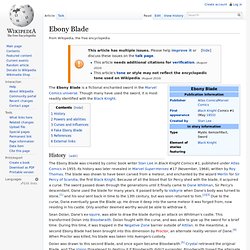
It is said to be indestructible, and nothing in the comics to date has disproven that statement. It also has many mystical or quasi-mystical capabilities, including the ability to: cut through virtually any physical substance except other enchanted weapons or extremely strong metals like adamantium, even to the point that it has been shown capable of breaking through Iron Man's Extremis armor with one slashcut through mystical barriersdeflect energy when angled correctlyabsorb all forms of energy, even the Promethean Flame Additionally, the Blade bonded to its wielder in such a way that the wielder can summon it back to himself or herself using a mystical ceremony if it is ever lost, even if it was in a different time period. The Blade formerly rendered its wielder invulnerable to everything except another weapon carved from the same meteor, such as the Ebony Dagger.
Excalibur. Glamdring (Sindarin: Foe-hammer) Godric Gryffindor's Sword. Grayswandir. Axe of Hereward. Frakir. Kanajana. Sword of Martin the Warrior. Morgul-blade. Mournblade. Narsil (Quenya: roughly, Red and White Flame) Nehima. The Swords of Night and Day. Orcrist (Sindarin: Goblin-cleaver) The Runestaff. Ruyi Jingu Bang. A 19th-century drawing of Sun Wukong featuring his staff.
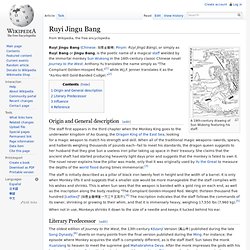
Origin and General description[edit] The staff is initially described as a pillar of black iron twenty feet in height and the width of a barrel. It is only when Monkey lifts it and suggests that a smaller size would be more manageable that the staff complies with his wishes and shrinks. This is when Sun sees that the weapon is banded with a gold ring on each end, as well as the inscription along the body reading "The Compliant Golden-Hooped Rod. Weight: thirteen thousand five hundred [catties]" (如意金箍棒重一万三千五百斤).[4] The inscription indicates that the staff follows the commands of its owner, shrinking or growing to their whim, and that it is immensely heavy, weighing 17,550 lbs (7,960 kg).[5] When not in use, Monkeys shrinks it down to the size of a needle and keeps it tucked behind his ear.
Literary Predecessor[edit] Snaga, the Sender. Soulsword. The Sword of Shannara. The Sword of the Dawn. Sting (Middle-earth) Bilbo named the blade after fighting giant spiders in Mirkwood.
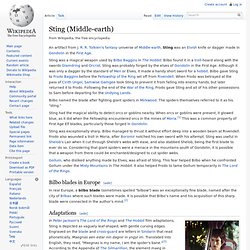
The spiders themselves referred to it as his "sting. " Sting was exceptionally sharp. Bilbo managed to thrust it without effort deep into a wooden beam at Rivendell. Frodo also wounded a troll in Moria, after Boromir notched his own sword with his attempt. Sting was useful in Shelob's Lair when it cut through Shelob's webs with ease, and also stabbed Shelob, being the first blade to ever do so. Gollum, who disliked anything made by Elves, was afraid of Sting. In real Europe, a bilbo blade (sometimes spelled "bilbow") was an exceptionally fine blade, named after the city of Bilbao where such blades were made. Stormbringer. Description[edit] Stormbringer's hunger for souls is such that it frequently betrays Elric by creating a bloodlust in his mind, turning in his hands and killing friends and lovers.
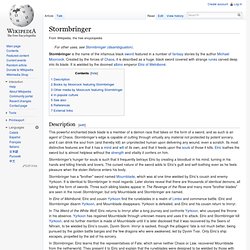
The cursed nature of the sword adds to Elric's guilt and self-loathing even as he feels pleasure when the stolen lifeforce enters his body. Stormbringer has a "brother" sword named Mournblade, which was at one time wielded by Elric's cousin and enemy Yyrkoon. It is identical to Stormbringer in most regards. The Sword of Truth. Vasilis, the sword of light and darkness. Vorpal sword. "Vorpal" redirects here.
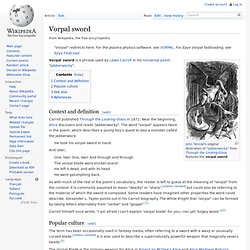
For the plasma physics software, see VORPAL. For Epyx Vorpal fastloading, see Epyx FastLoad. Vorpal sword is a phrase used by Lewis Carroll in his nonsense poem "Jabberwocky". Context and definition[edit] He took his vorpal sword in hand: And later, One, two! The vorpal blade went snicker-snack! He left it dead, and with its head He went galumphing back.
As with much of the rest of the poem's vocabulary, the reader is left to guess at the meaning of "vorpal" from the context. Carroll himself once wrote, "I am afraid I can't explain 'vorpal blade' for you—nor yet 'tulgey wood Popular culture[edit] The term has been occasionally used in fantasy media, often referring to a sword with a wavy or unusually curved blade. Werewindle.